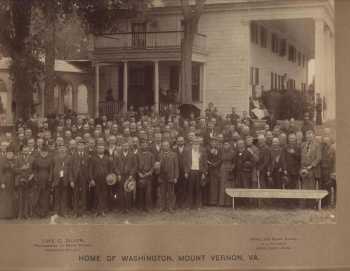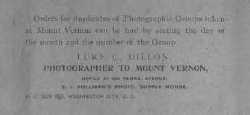Sign up for the Family Tree Newsletter Plus, you’ll receive our 10 Essential Genealogy Research Forms PDF as a special thank you!
Get Your Free Genealogy Forms
"*" indicates required fields
 |
 |
| Front | Back (detail) |
This portrait is a wonderful example of how family history is about putting all the pieces together. Elaine Clark submitted this picture because “it has been giving her fits.” Almost forgotten, it once had a beautiful frame and, according to Elaine’s elderly mother, hung in Elaine’s grandparents’ house. However, no one could remember why the picture had a prominent place in their house or to which side of the family it belonged.
The first time I looked at the picture I knew it was a group of Grand Army of the Republic (GAR) members because of their uniforms. This organization was founded in 1866 in Decatur, Ill., for honorably discharged Union veterans of the Civil War. GAR “posts” held encampments, multi-day events which often included camping out, formal dinners and memorial events. Nationwide, the group also founded soldiers’ homes, was active in relief work and in pension legislation, according to the Sons of Union Veterans of the Civil War Web site at suvcw.org. Membership peaked at 400,000 in 1890 and the organization didn’t dissolve until 1956. Many of its members wore uniforms and caps, which were manufactured especially for GAR members. Pictured here is a mix of men wearing uniforms and regular dress.
The imprint on the front and back of this photograph says “Luke C. Dillon.” Written on the back are instructions for ordering duplicates and in pencil, “Sept. 21-7.” According to Barbara McMillan of Mount Vernon, Luke C. Dillon was the official photographer from 1880 to 1890 for the famous home of George Washington. During the Civil War, Mount Vernon was neutral ground and under the jurisdiction of the Mount Vernon Ladies Association. Soldiers from both sides were invited to visit the grounds as long as they left their guns outside the gate. After the war, Mount Vernon was a popular tourist site for groups visiting battlefields in the area. While the day and month of the photograph are clearly marked on the picture, there is no year, only that mysterious “7” notation after the date.
Initially, I thought the number referred to the year 1887. However, clothing clues disagreed. In every group portrait, there is a mix of current fashion and older styles. Since the men in this picture have similar suits and uniforms, it is the women’s clothing that assigns a timeframe. In the front row there are three women, one on the left and two on the right, wearing stylish outfits complete with hats. As it turns out, their hats supplied a tentative year for the picture. Demorest’s Monthly Magazine of July 1889 contained illustrations of bonnets called “Midsummer Millinery” featuring small bonnets worn on top of the head with a decoration on top. The women in this photo are wearing hats very similar in shape and height to those in the 1889 magazine article. Since the bonnets date from 1889 rather than 1887, “7” may have referred to the seventh group photographed on Sept. 21.
When I contacted Elaine Clark for additional information on Civil War veterans in her family tree, she sent me numerous newspaper clippings for her relatives. In a 1978 Shinnston [WV] News article, a nephew recalled the life of Jesse Tyler Sturm and his stories about Civil War exploits. Of all the information Elaine sent me, only this story seemed to match the photograph. Essentially an oral history of the Sturm family, this article—combined with details from the picture—added material to the family album about both Sturm and his wife Lavinia Jane (Hess).
According to the article, Jesse Tyler Sturm nearly died at the Battle of Fisher’s Hill in Virginia on Sept. 22, 1864. Serving with Company H of the 14th West Virginia Volunteer Infantry, he hid behind a small tree and escaped the 42 bullets that hit his clothing, equipment and the tree. More than 528 Union soldiers died during that battle and it was a miracle that Sturm survived.
At the battle of Fisher’s Hill, Jesse Tyler Sturm found refuge but his friend and neighbor, Robert Nelson Hess did not.
“I was still very bloody, though I washed it off my face and hands,” Sturm wrote in his journal. “But I had the blood of three men upon me—the Sergeant’s, the Lieutenant’s and my own.” Jesse Tyler Sturm’s handwritten account of the Civil War was recently rediscovered and featured in the Wichita Eagle.
After the battle, Sturm buried his friend on the grounds of a Union sympathizer. At the end of the War, Robert’s brother George and Sturm returned to the site and retrieved the body for burial on the family farm. A few years later, Jesse Tyler Sturm married Robert and George’s sister Jane.
In November 1889, Sturm wrote a letter to his father-in-law in saying he would visit him in the late summer of the following year. As promised, Jesse Tyler Sturm and his wife joined the GAR in a large rally in Boston and then spent time visiting battlefields of the Shenandoah Valley in Virginia. During this tour, he retrieved bullets from the tree (which he had marked for future reference) and brought his wife to the site where her brother died.
So what is the date of the picture? Sept. 21, 1890—one day short of the battle’s 26th anniversary. By putting all the pieces together, the true story of the mysterious photograph came to light. No one source contained all the clues to the pictures; instead, the facts had to sorted out and compared with historical events before a complete story could be told.
Find out how to submit your own picture for possible analysis by Maureen Taylor. E-mail her at mtaylor@taylorandstrong.com.
ADVERTISEMENT

